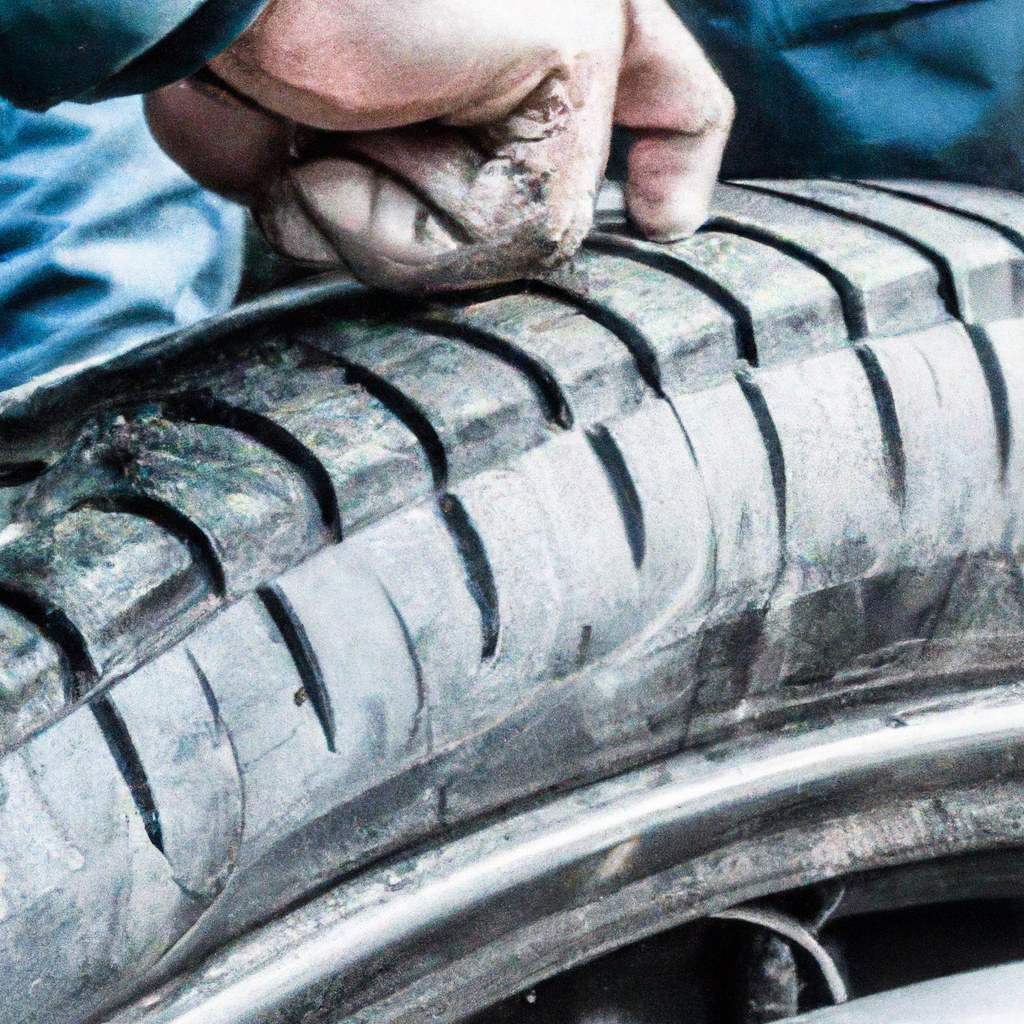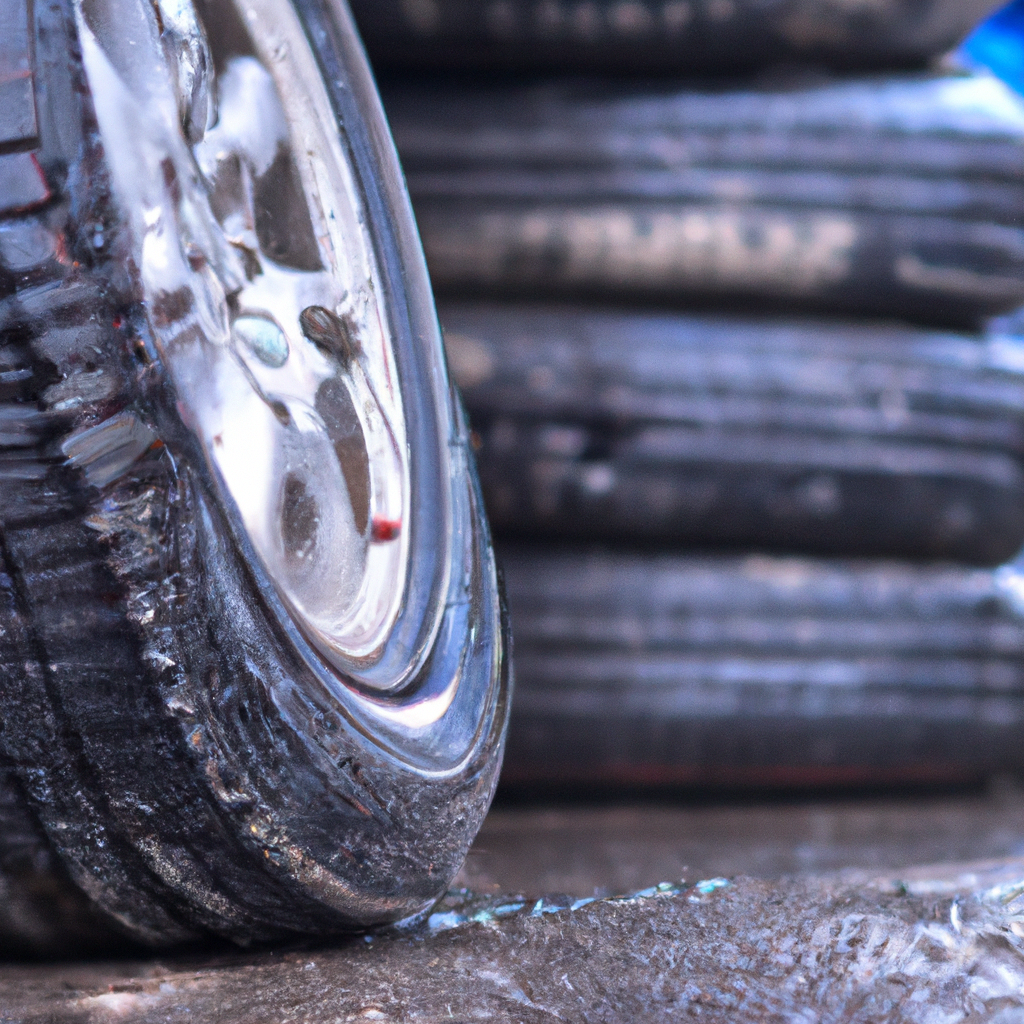You’ve just finished replacing your car’s tires, enjoying the smooth ride and improved traction. But suddenly, you notice a subtle wobble in your steering and a strange hissing sound. Could it be a tire bead leak? In this article, we’ll explore the causes of tire bead leaks and provide simple yet effective tips on how you can prevent them from disrupting your enjoyable drive. So buckle up and let’s dive into the world of tire maintenance together!
Regularly Inspect and Maintain Tires
Check Air Pressure
Maintaining proper tire air pressure is essential for the overall performance and safety of your vehicle. Properly inflated tires can improve fuel efficiency, enhance handling, and extend tire life. To ensure your tires are inflated to the correct air pressure, it’s important to regularly check them with a tire pressure gauge. The manufacturer’s recommendation for the ideal air pressure can usually be found on a sticker located on the driver’s side door jamb or in the vehicle’s owner’s manual. Remember to check your tire pressure when they are cool, as heat from driving can cause the air inside to expand, leading to inaccurate readings. If the pressure is too low, add air accordingly. Conversely, if the pressure is too high, release some air until the desired pressure is reached.
Inspect for Damage
Regularly inspecting your tires for any signs of damage is crucial for your safety on the road. Look out for any cuts, punctures, bulges, or sidewall damage. If you notice any of these issues, it’s important to take action immediately. Damaged tires can compromise your vehicle’s performance and even lead to a blowout while driving. If you spot any signs of damage, it is recommended to consult a professional tire technician for further evaluation and potential replacement.
Monitor Tread Wear
Monitoring the tread wear on your tires is another important aspect of maintenance. Tires with insufficient tread depth can result in reduced traction, especially in wet or snowy conditions. The easiest way to check the tread depth is by using a tread depth gauge. Insert the gauge into the tread grooves and measure the depth. If the tread depth is below the legal limit or if you notice significant uneven wear, it’s time to replace your tires. Regularly rotating your tires, as we will discuss later in this article, can help promote even wear and prolong the lifespan of your tires.
Ensure Proper Tire Installation
Choose a Reputable Tire Shop
When it comes to installing or replacing your tires, it’s important to choose a reputable tire shop. A reliable tire shop will have experienced technicians who can ensure proper installation and provide expert advice. Check for reviews and recommendations to find a shop that has a good reputation and offers quality service. By selecting a reputable tire shop, you can have peace of mind knowing that your tires will be installed correctly and safely.
Verify Correct Tire Size
Before having new tires installed on your vehicle, it is crucial to verify that the tire size matches your vehicle’s specifications. Using the wrong tire size can negatively affect your vehicle’s handling and performance. The correct tire size can usually be found in your vehicle’s owner’s manual or on the sidewall of your current tires. If you are unsure, consult a professional or the tire manufacturer for guidance.
Ensure Proper Bead Seating
During tire installation, it’s important to ensure the beads, which are the inner edges of the tire that create an airtight seal with the rim, are properly seated. Improper bead seating can result in air leaks, leading to decreased tire performance and potential safety hazards. A reputable tire shop will have the necessary equipment and expertise to ensure proper bead seating. If you have concerns about the bead seating, it is recommended to have a professional check and adjust it to avoid any potential issues.

Install and Use Valve Stem Caps
The Importance of Valve Stem Caps
Valve stem caps are small but crucial components of your tires. They serve as protective covers for the valve stems, which are responsible for inflating and deflating the tires. Valve stem caps help prevent dirt, debris, and moisture from entering the valve stems, which can cause leaks or damage over time. They also provide an additional layer of protection against air loss. Using valve stem caps is a simple yet effective way to enhance the longevity and performance of your tires.
Proper Installation
Installing valve stem caps is a quick and straightforward process. Start by removing the old caps, if present, and clean the valve stems with a soft cloth. Make sure there is no dirt or debris on the stems before installing the new caps. Simply place the caps over the valve stems and screw them on tightly. It’s important to note that over-tightening can damage the valve stems, so use moderate force when securing the caps.
Regularly Check Valve Stem Caps
After installing valve stem caps, it’s important to regularly check their condition. Over time, the caps may become loose or damaged, compromising their effectiveness. Inspect the caps for any signs of wear or damage, such as cracks or missing parts. If you notice any issues, replace the caps promptly. Regularly checking and maintaining the condition of valve stem caps will help ensure optimum tire performance and prevent potential leaks.
Avoid Overinflating or Underinflating Tires
Understand Recommended Air Pressure
Maintaining the recommended air pressure in your tires is crucial for their performance and longevity. Overinflating or underinflating tires can lead to uneven wear, poor handling, and reduced fuel efficiency. To avoid these issues, it’s important to understand the recommended air pressure for your specific tires. As mentioned earlier, this information can usually be found on a sticker inside the driver’s side door jamb or in the vehicle’s owner’s manual. Make sure to follow the manufacturer’s recommendations to achieve optimal tire performance.
Use a Reliable Pressure Gauge
To accurately measure and adjust tire pressure, it’s essential to use a reliable pressure gauge. There are various types of pressure gauges available, including digital and analog options. Choose a gauge that is easy to use and provides accurate readings. Keep in mind that tire pressure can fluctuate with changes in temperature, so it’s best to check it when the tires are cool. Regularly checking and adjusting tire pressure will help maintain optimum performance and ensure your safety on the road.
Check and Adjust Tire Pressure Regularly
Checking and adjusting tire pressure should be part of your routine maintenance tasks. It is recommended to check your tire pressure at least once a month or before long trips. Regularly monitoring the air pressure allows you to detect any gradual loss of pressure and address it promptly. If the tire pressure is too low, add air until the desired pressure is reached. Conversely, if it is too high, release some air to achieve the recommended level. By making tire pressure checks and adjustments a regular habit, you can prevent overinflation or underinflation and promote optimal tire performance.

Be Mindful of Road Hazards
Avoid Potholes and Obstacles
Potholes and other road hazards can pose a significant risk to your tires. When driving, be attentive to the road conditions and try to avoid potholes or other obstacles whenever possible. Hitting a pothole or a sharp object on the road can cause damage to your tires, such as cuts, bulges, or punctures. These damages can weaken the tire structure and increase the likelihood of a blowout. Additionally, hitting a pothole at high speeds can also affect your vehicle’s alignment and suspension components. Therefore, it is important to exercise caution and maneuver carefully to avoid potential tire and vehicle damage.
Exercise Caution on Rough Terrains
If you frequently drive on rough terrains or unpaved roads, it’s even more crucial to be mindful of the condition of your tires. Rough terrains can subject your tires to increased stress and impact, leading to accelerated wear and tear. To mitigate these risks, drive cautiously on rough surfaces and avoid excessive speeding or sudden maneuvers. A slower and more controlled driving approach helps reduce the strain on your tires and minimizes the chances of damage.
Inspect Tires After Hitting Curb or Obstructions
Even if you are cautious on the road, accidents can still happen. If you accidentally hit a curb or any other obstruction, it’s important to inspect your tires afterwards. The impact can cause visible damage, such as sidewall bulges or cuts, that may not be immediately noticeable. Check for any signs of damage and pay attention to any changes in tire performance, such as vibrations or changes in handling. If you suspect that the tires may have been affected, have them inspected by a professional to ensure your safety.
Properly Clean and Dress Tires
Select Tire Cleaning Products Carefully
Properly cleaning your tires not only helps maintain their appearance but also contributes to their overall health and longevity. When selecting tire cleaning products, it’s important to choose those specifically designed for tires. Look for products that are non-abrasive and specifically formulated to remove dirt, dust, and grime without damaging the rubber. Avoid using harsh chemicals or household cleaners, as they can deteriorate the tire’s rubber compound and potentially cause discoloration or cracking.
Avoid Using Harsh Chemicals
Harsh chemicals, such as bleach or strong solvents, should be avoided when cleaning your tires. These substances can strip away the protective layers of the tire and cause premature aging. Instead, opt for mild soap or dedicated tire-cleaning products. Make sure to follow the manufacturer’s instructions when using cleaning products and rinse thoroughly afterwards.
Apply Tire Dressing Correctly
Tire dressing is a product that can enhance the appearance of your tires while also providing some protection against UV rays and moisture. When applying tire dressing, it’s important to do so correctly. Start by cleaning the tires thoroughly to remove any dirt or grime. Once the tires are clean and dry, apply the dressing evenly on the sidewalls, being careful not to get any on the treads. Allow the dressing to dry completely before driving. Regularly applying tire dressing can help preserve the tire’s appearance and protect it from weathering.

Rotate Tires Regularly
Importance of Regular Tire Rotation
Regularly rotating your tires is key to promoting even tread wear and extending their lifespan. Due to variations in weight distribution and the different forces experienced by each tire position, the front and rear tires can wear at different rates. By rotating the tires, you ensure that they wear more evenly, which improves overall traction and prolongs their lifespan. Additionally, tire rotation can help maintain proper vehicle alignment and maximize fuel efficiency.
Follow Manufacturer’s Recommendations
To determine the appropriate tire rotation pattern for your vehicle, it is best to refer to the manufacturer’s recommendations. The recommended rotation interval can vary depending on factors such as tire type, driving conditions, and vehicle specifications. In general, it is recommended to rotate the tires every 5,000 to 7,000 miles or as advised by the manufacturer. Following the recommended rotation pattern will help optimize tire performance and ensure a smooth and safe driving experience.
Consider Professional Rotation
While some individuals prefer to rotate their tires themselves, it is worth considering having a professional handle the task. Tire rotation can involve specific techniques and equipment to ensure proper balance and alignment. A professional tire technician will have the expertise and tools to perform an accurate rotation and identify any potential issues. Moreover, having your tires rotated at a reputable tire shop can also provide an opportunity for a comprehensive inspection of the tires, which can help identify any signs of damage or wear.
Replace Damaged or Worn-out Tires
Monitor for Signs of Damage or Wear
Regular monitoring of your tires is essential to identify any signs of damage or excessive wear. Even with proper maintenance, tires will eventually wear out and need to be replaced. Signs of tire wear include low tread depth, uneven wear patterns, sidewall cracks, bulges, or any damage that compromises the integrity of the tire. If you notice any of these signs, it is crucial to have your tires evaluated by a professional tire technician. They can provide expert advice on whether the tires can be repaired or if replacement is necessary.
Be Aware of Tire Aging
In addition to wear and tear, tires can also age over time. Rubber compounds can deteriorate due to exposure to UV rays, extreme temperatures, and other environmental factors. The age of a tire can be determined by the DOT (Department of Transportation) number on the sidewall, which indicates the week and year of manufacture. As a general guideline, it is recommended to replace tires that are six years or older, regardless of their tread depth or overall condition. Aging tires can become more prone to failures and may compromise your safety on the road.
Consult Professional for Evaluation
When in doubt about the condition of your tires, it is always advisable to consult a professional tire technician for a thorough evaluation. They have the expertise and knowledge to properly assess the condition of your tires and provide appropriate recommendations. By seeking professional help, you can ensure that your tires are in good condition and that you are driving safely.

Store Tires Properly
Clean and Dry Tires Before Storage
If you need to store your tires for an extended period, it’s important to clean and dry them before doing so. Remove any dirt, debris, or brake dust from the tires using a mild soap and water solution. Be sure to rinse them thoroughly and allow them to dry completely. Storing dirty or damp tires can lead to the growth of mold or mildew, potentially causing damage to the rubber.
Use Tire Covers or Bags
When storing tires, it’s recommended to use tire covers or bags to provide an extra layer of protection. Tire covers or bags shield the tires from direct sunlight, UV rays, and dust, which can degrade the rubber compound and affect tire performance. Additionally, they help prevent any accidental punctures or abrasions that may occur during storage.
Store Tires in a Cool and Dry Location
The location where you store your tires is also important. Tires should be stored in a cool, dry, and well-ventilated area. Extreme temperatures, high humidity, and exposure to direct sunlight can accelerate tire aging and degradation. It’s best to store tires away from direct sunlight, heaters, or any sources of ozone, as these can cause the rubber to deteriorate prematurely.
Consider Using Sealants or Bead Sealers
Types of Sealants and Bead Sealers
Sealants and bead sealers are products designed to help prevent or repair tire bead leaks, which occur when the tire’s bead does not create a proper seal with the rim. There are various types of sealants and bead sealers available, including liquid sealants and adhesive sealants. Liquid sealants are typically injected into the tire through the valve stem, while adhesive sealants are applied to the tire bead before installation. Both types work by filling in small gaps or imperfections, helping to create an airtight seal.
Application Process
The application process for sealants and bead sealers can vary depending on the product and manufacturer’s instructions. For liquid sealants, it usually involves injecting the sealant into the tire through the valve stem. It’s important to follow the recommended dosage provided by the manufacturer to ensure optimal results. Adhesive sealants, on the other hand, are typically applied to the tire bead before mounting the tire onto the rim. Carefully follow the instructions provided by the manufacturer to ensure proper application and adhesion.
Considerations and Limitations
While sealants and bead sealers can be effective in preventing and repairing tire bead leaks, it’s important to consider their limitations. Sealants are not a permanent solution and may need to be reapplied periodically. Additionally, some sealants can cause tire imbalance or damage if used in excessive amounts. It is best to consult a professional tire technician before using any sealant or bead sealer to ensure that it is suitable for your specific tire and rim combination.
By following these guidelines and incorporating them into your regular tire maintenance routine, you can ensure that your tires remain in optimal condition. Regular inspection, proper installation, correct air pressure, and diligent care will not only extend the life of your tires but also enhance your safety and driving experience. Remember, when it comes to tire maintenance, prevention is key – taking proactive steps to prevent issues before they arise will save you time, money, and potentially prevent accidents on the road. So, make tire maintenance a priority and enjoy worry-free driving for miles to come!


